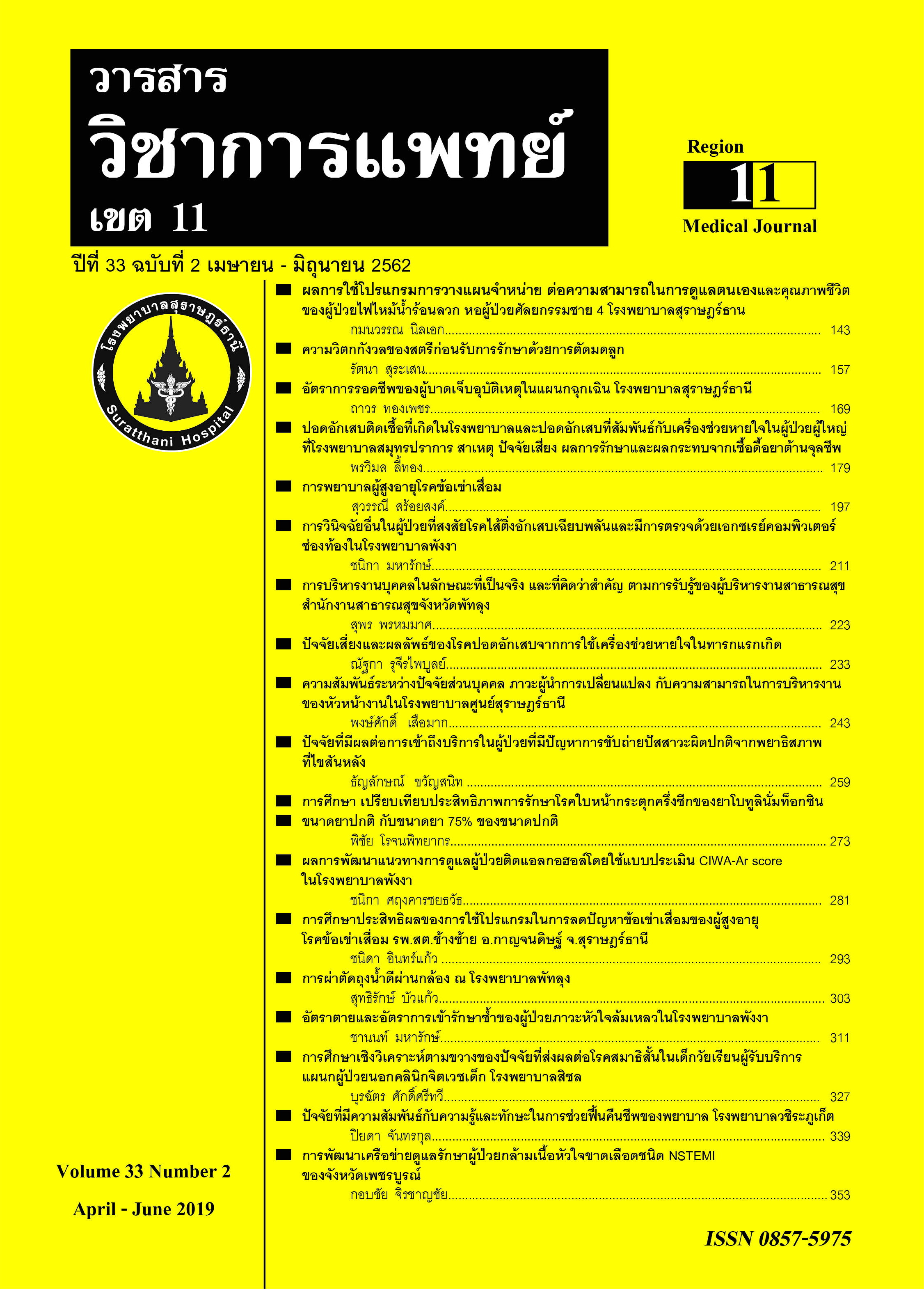Women’s Anxiety before Hysterectomy
Keywords:
Anxiety, Before HysterectomyAbstract
Generally, receiving hysterectomy led women to get anxiety. Anxiety often presented by post-operation pain, cancer manifestation, anesthesia, post-operative care, and post-operative complication, etc.
This descriptive research aimed to study: 1) anxiety level before hysterectomy, 2) causes of women’s anxiety and anxiety level in each cause. Subjects were 129 women diagnosed of gynecological diseases and needed to get hysterectomy; except cancer. They admitted to the gynecological ward, Suratthani
hospital, during October, 2015 to September, 2016. Instruments were a demographic data State Anxiety Inventory assessment form, and causes of anxiety record form. Data were analyzed using descriptive statistic: percent, mathematic mean, and standard deviation.
Results: overall, subjects showed moderate anxiety level as scores of 26-74 (= 48.3, SD=9.4). Causes of high anxiety level were post-operative complication (=7.9, SD=2.9), pain (=7.8, SD=2.7), post-operative care (=7.5, SD=3.1), and cancer manifestation (=7.1, SD= 3.5). Causes of moderate anxiety level were anesthesia (=6.0, SD= 3.2) and sexual intercross (= 5.4, SD= 3.4). A cause of low anxiety level was missed pregnancy (=2.8, SD=3.0).
Findings of this study could be database in order to provide appropriate nursing care for anxiety reducing in women receiving hysterectomy
References
2. Carlson, K.J., Miller, B.A., & Fowler, F.J. The main women’s health study: Outcomes of hysterectomy. Obstetrics & Gynecology 1994; 83: 556-564.
3. ขนิษฐา นาคะ. ความวิตกกังวลและความต้องการข้อมูลในผู้ป่วยก่อนผ่าตัด. วิทยาศาสตรมหาบัญฑิต สาขาพยาบาลศาสตร์บัณฑิตวิทยาลัย มหาวิทยาลัยมหิดล; 2534.
4. Spielberger, C.D. Manual for the state-traitanxiety inventory. (STAI) form Y: Self evaluation Guestionare; 1983.
5. Dossey, B. Help your patient break free from anxiety. Nursing 1996; 26(10):52-54.
6. Barrett, M.B. Perioperative Nursing. A psychophysiology approach. Philadelphia: W.B. Saunders; 1993.
7. Kjerlff, K.,Langenberg, P., Rhodes, J., Guzinski, G.,&Stolley, P. Effectiveness of hysterectomy. Obstetrics and Gynecology 2000; 95: 319-326.
8. Gul, P., Seyda, O., Nevin, D., Lale, B.,& Ali, A. The Effects of Hysterectomy on Body Image, Self-Esteem, and Marital Adjustment in Turkish Women With
Gynecologic Cancer. Clinical Journal of Oncology Nursing 2012; 16(3): 99-104.
9. Kaisa, N., Tarja, S.,& Merja N. Representations of hysterectomy as a transition process in Finish women’s and health magazines. Scandinavian Journal of Caring Sciences, Nordic College of Caring Science 2011; 608-616.
10. Spielberger,C.D.,Gorsurch,R.L.,& Luschene,R.E. STAI Manual. California: Consultimg Psychologists Press,Inc;1972.
11. Lin L,Y. & Rang R,H. Abdominal surgery pain and anxiety: Preoperative nursing intervention 2005;51(3):252- 260.
12. เอื้องพร พิทักษ์สังข์, จุฑาไล ตันฑเทิดธรรม, สุกัญญา ศุภฤกษ์, อรทัย วรานุกูลศักดิ์. การศึกษา ความ วิตกกังวล ความเครียดและความต้องการข้อมูลของผู้ป่วยก่อนได้รับการผ่าตัดทางตาแบบผู้ป่วยนอก. วารสารพยาบาลศิริราช 2554; 4(1):35-42.
13. กัญญาณัฐ สิทธิภา, ฉวี เบาทรวง, นันทพร แสนศิริพันธ์. ความวิตกกังวล การสนับสนุนทางสังคม และความสามารถในการปฏิบัติหน้าที่ในระยะหลังคลอดของผู้เป็นมารดาครั้งแรก. พยาบาลสาร 2560; 44(3): 30-40.
14. ดวงดาว อรัญวาสน์, สิริรัตน์ ตรีพุทธรัตน์, เทพกร สาธิตการมณี และกชกร พลาชีวะ. ผลการให้ข้อมูล อย่างมีแบบแผนต่อความวิตกกังวลของผู้ป่วยที่มารับบริการระงับความรู้สึกแบบทั้งตัว. วิสัญญีสาร 2555;38 (2),102-108.
15. เรณู อาจสาลี. การพยาบาลผู้ที่มารับการผ่าตัด. กรุงเทพ: เอ็น พี เพรส; 2550.






